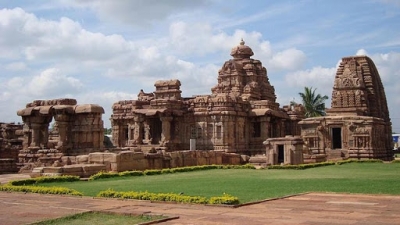
Pattadakal, in Karnataka, represents the high point of an eclectic art which, in the 7th and 8th centuries under the Chalukya dynasty, achieved a harmonious blend of architectural forms from northern and southern India. An impressive series of nine Hindu temples, as well as a Jain sanctuary, can be seen there. One masterpiece from the group stands out – the Temple of Virupaksha, built c. 740 by Queen Lokamahadevi to commemorate her husband’s victory over the kings from the South.
The rise of the Chalukyas marks an important milestone in the history of South India and a golden age in the history of Karnataka. The political atmosphere in South India shifted from smaller kingdoms to large empires with the rise of Badami Chalukyas. For the first time in history, a South Indian kingdom took control and consolidated the entire region between the Kaveri and the Narmada rivers. The rise of that empire also saw the birth of efficient administration, rise in overseas trade and commerce and the development of new style of architecture called Vesara. Around the ninth century, it also saw the growth of Kannada as a language of literature in the Jaina Puranas, Veerashaiva Vachanas and Brahminical traditions. The eleventh century saw the birth of Telugu literature under the patronage of the Eastern Chalukyas.
The rock-cut temples of Pattadakal, a UNESCO World Heritage Site, Badami and Aihole constitute their most celebrated monuments.That marks the beginning of Chalukya style of architecture and a consolidation of South Indian style.
In Aihole, the Durga temple (sixth century), Ladh Khan temple (450), Meguti temple (634), Hucchimalli and Huccappayya temples (fifth century), Badami Cave Temples (600) provide examples of early Chalukyan art. Vikramaditya II (740) commissioned the majestic temples at Pattadakal. Here the Virupaksha and Mallikarjuna (740), Sangameswara (725) and a Jain temple display the Dravidian style while Jambulinga, Kasivisweswara, and Galaganatha (740) show the Northern nagara style. The Papanatha (680) temple shows an attempt to combine the Northern and Southern styles.
Picture Credit : Google




